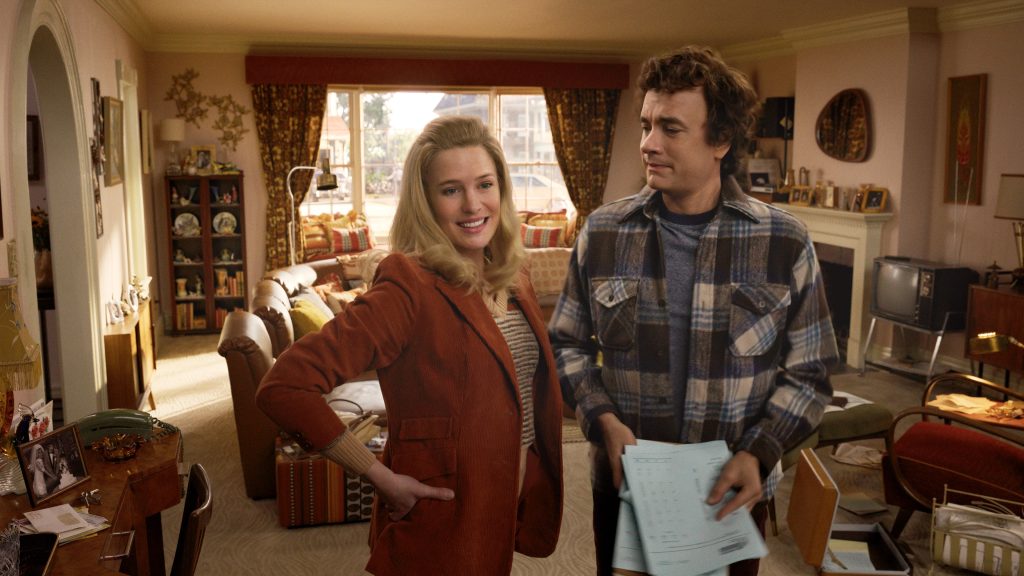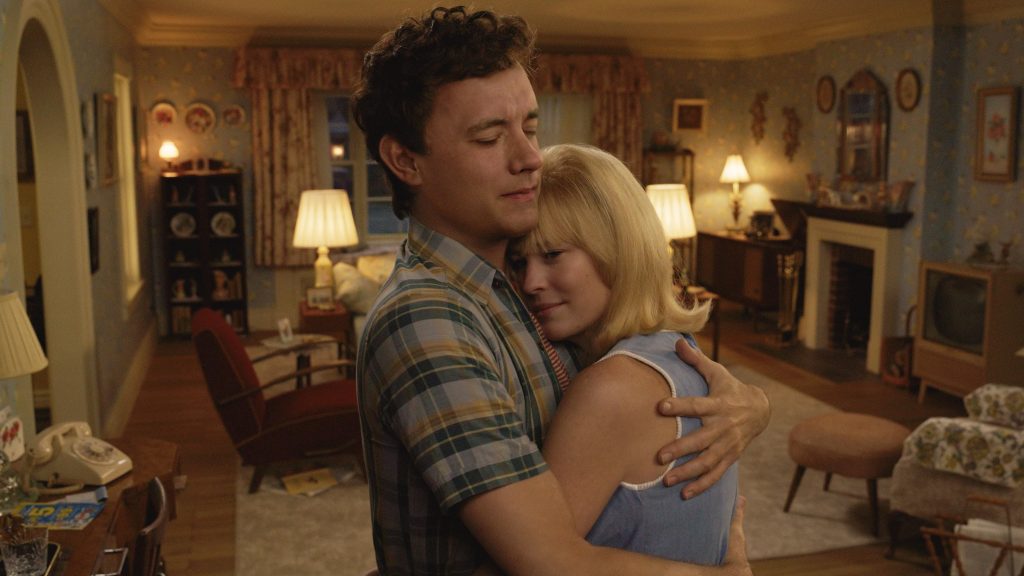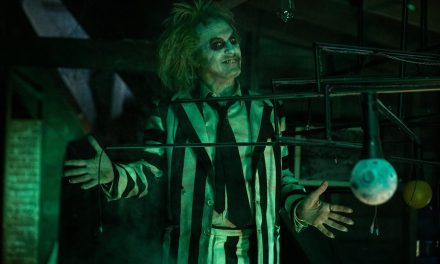Leo Tolstoy’s Anna Karenina opens with the musing that “all happy families are alike; each unhappy family is unhappy in its own way.” In Here, Robert Zemeckis’ adaptation of Richard McGuire’s graphic novel, the statement flips: unhappy families are all alike, too. This is not to say each family in Here is wholly unhappy or that any family is unhappy the entire time, of course. But the film sets itself on a singular plot of land, faced in one direction, as life proceeds from its earliest beginnings until the modern era. Families rise, grow, wither, and fall in patterned ways, cities emerge and change, and we follow them all in chronologically sliding snippets, all from a singular, unmoving space.
In one way, Here loosely resembles Yasujirō Ozu on steroids, the lauded Japanese filmmaker famous for both telling stories about families in a changing world and for rarely moving the camera within a scene. Zemeckis’ film takes it spatially one step further in its thorough unwillingness to shift the camera’s orientation throughout Here’s runtime, opting instead for the use of comic-style windows to introduce new temporal moments and eras. It’s an interesting experiment, forgoing cinema’s evolutions from the stage (like its ability to shift space and perspective) in order to highlight the progression of time.
If there’s a centerpiece here, it’s the Young family, whose WWII-surviving patriarch Al (Paul Bettany) comes to acquire the house the film predominantly sticks to, building a home with his wife Rose (Kelly Reilly). Their son Richard (Tom Hanks) comes to take over the house, along with his life long love Margaret (Robin Wright) and their family. Various interludes also follow Lay-Z-Boy inventor Leo (David Fynn) and his love Stella (Ophelia Lovibond) in the house in an earlier era, and Mrs. Harter (Michelle Dockery) and her family in an earlier era still, but the crux of the narrative rests with the Youngs just as it begins and ends with Richard.
It’s somewhat ironic that Here marks a collaborative return for Tom Hanks, Robin Wright, and Zemeckis, 30 years after their Academy Award winning turn in Forrest Gump; the films are opposites of sorts, with Gump highlighting a man who literally runs his way into the history books, while Here’s central conceit is the elimination of any spatial movement outside a single room. The conceit eliminates any extraneous variables – fancy edits or cinematography, wild plot twists, and so on. As a consequence, it puts both strengths and weaknesses into sharp contrast.

Hanks is unsurprisingly good as Richard, carrying the character well through a wide range of ages and plot beats. He still has exceptional chemistry with Wright, who is easily one of the film’s central MVP’s, anchoring perhaps its two most powerful moments in Margaret’s 50th birthday and the final scene. Also worth noting are Fynn and Lovibond’s Leo and Stella, who don’t contribute much to the central plot or themes but who practically bleed with electric and erotic mutual chemistry. It’s always a breath of fresh air whenever they’re onscreen.
The single-orientation/location format does few favors to some of the other players. As Al, Bettany is reduced to a hard-drinking curmudgeon whose 1950’s-era dialogue may or may not ring true to the era, but who is saddled with a number of to-the-camera soliloquies in that archaic sounding dialogue style, forcing him to turn to the camera and deliver long, stiff monologues reminiscent of a mid-tier high school audition. It’s a choice that serves nothing and never works.
Dockery is another charismatic talent given little to latch onto, playing a widowed housewife of an earlier era saddled with stiff dialogue in uneventful B or C subplots. Sure, speech may have been more formal in earlier eras of American history, but we had Whitman, Dickinson, and Hughes, Steinbeck, Hemingway, and Faulkner. There’s no need to pretend that American speech of earlier eras had to be as exciting as a list of pharmaceutical side effects, and you also don’t need to give that list a soliloquy.

The comic book-esque windows providing transition and bleeding past, present, and future into each other work extremely well. It’s a nice throwback into the film’s graphic novel roots, and it provides the film’s main source of progression and momentum. At the same time, the static camera is a worthy cinematography and narrative experiment – it works better than expected – but it’s still a gimmick that doesn’t entirely work. The plot bounces between time periods to provide narrative advancement and thematic exploration, but it’s clear that the Youngs are the focus… how does the narrative benefit from the extraneous time periods?
Here sometimes flits so quickly between scenes and characters that it’s hard to find the emotion in what befalls them. Richard’s brother causes tension for signing up for the military. Are… we supposed to care about Richard’s brother? Is this a problem because of some sort of political stance we’ve never seen Richard take? And Richard’s scene of distress barely lands before the film moves on. Sitting longer with many moments and characters would help these moments work better.
Altogether, Here is a somewhat worthwhile novelty. The singular perspective is a rarity, and hats off to it. The temporal sliding is a unique way to tell a story, and the de-aging of the major players is largely successful (minus a few close-ups). The comic-esque boxes are well utilized and successfully echo the source material. At the same time, Zemeckis’ turn-to-the-camera moments, with soliloquy or without, are ill-advised. Some dialogue is clunky and fails to ring true, and worse yet, given minute-long soliloquy moments that can’t be passed over. The film sticks the landing thanks to Wright’s heartfelt performance, but the journey is messy and uneven. Here has its moments, but like its ever-watching eye-of-god camera, it remains a stagnant observer with unmet potential.

![‘Here’ Is A Novel, But Wildly Uneven, Cinematic Experiment. [REVIEW]](https://thathashtagshow.com/wp-content/uploads/2024/10/project_20241028_1121253-01-1280x640.png)


![Star Wars: The Clone Wars – Bo-Katan Kryze Mini Bust [Review]](https://thathashtagshow.com/wp-content/uploads/2023/04/bo-katan-mini-bust-review-440x264.jpg)
